How to get good beading tension
How to get good beading tension is a question that often comes up in my classes. I am constantly thinking about how to help people improve. My thoughts led me to consider how different tension is appropriate for different stitches and projects. Beading tension is something that is very personal and it can be hard to change.
So, I want to talk about what beading tension means and how to use it to help you. I also want to offer you a few tips regarding materials. So, if you have been wondering how to get good beading tension, I hope this will help.
What is beading tension?
Basically, it is how firmly you pull the beads into place as you stitch. If you are familiar with other crafts, you may be familiar with the concept. It can also be applicable in knitting, crochet and sewing. To look at it another way, it is the amount of force you use on your materials as you are trying to get them to behave as you wish.
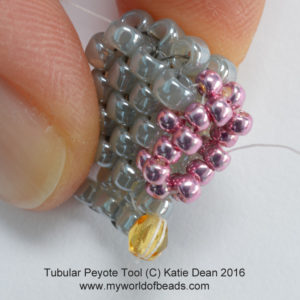 Beading tension is important because it affects how your beads lock together. This, in turn, affects the neatness and the stability of your finished work. Everyone who starts beading finds they have a ‘natural’ tension. Some people believe this may be a reflection of your personality. If you are the type of person who is always busy, perhaps stressed, even ‘tense’, you may find you naturally pull your thread tight on every stitch. If you have a more relaxed or laid-back personality, you may find your tension is looser.
Beading tension is important because it affects how your beads lock together. This, in turn, affects the neatness and the stability of your finished work. Everyone who starts beading finds they have a ‘natural’ tension. Some people believe this may be a reflection of your personality. If you are the type of person who is always busy, perhaps stressed, even ‘tense’, you may find you naturally pull your thread tight on every stitch. If you have a more relaxed or laid-back personality, you may find your tension is looser.
I don’t mean to suggest that your beading tension is another way to psycho-analyse you! The point about this natural level of tension is it can be difficult to change. So, what do you do about it? Does it even matter? I will come on to the question of what to do in a minute.
Why beading tension matters
So, before we move on to the question of how to get good beading tension, I want to explain why it matters. Let me start by defining ‘good’ beading tension. It is basically a nice mid-point, so nothing too extreme in either direction.
Extreme Tight Tension
If your tension is extremely tight, you may find you have problems with thread breaking, or even beads breaking. At the very least, you will find it difficult to pass through beads that have been locked into place. You can find it tricky to knot between beads to start and finish new threads.
Whatever kind of weave you are creating, your beads will want some room to ‘breathe’. If you are making jewellery, it is going to flex naturally as it is worn. So, if your beads are locked too tightly together, you restrict their ability to respond to the movement of wear.
Extreme Loose Tension
At the other extreme, if your tension is very loose, you will have trouble pulling the beads into their desired position. This makes the actual process of beading a lot trickier. If your beads sit out of position, it is more difficult to tell which beads you need to enter on each stitch.
When it comes to the finished product, loose tension may also have an impact. If you are trying to create something that requires a level of stability, then loose tension will get in the way. Think of a three-dimensional Peyote object. The way in which the beads lock together is the only thing giving this stability. So, if your beads only lock loosely, the whole structure will be loose.
How to get good beading tension
To summarise, there is a ‘sweet spot’ where tension is just right. Happily, there is some flexibility in this, so this desirable mid-ground does still cover a broad range of tensions. Unhappily, I have yet to find a way of telling my students exactly what this ‘sweet spot’ is or precisely how to achieve it! Much of beading tension is about trial and error and finding your own way through. However, I hope I can offer a few ideas that you may find helpful to consider.
Techniques to Help (or Hinder) Beading Tension
The more different techniques you learn, the more you will come to appreciate that each one benefits from a slightly different beading tension. Peyote stitch and brick stitch both need a tight tension. They are designed to make a closely-woven fabric in which the beads lock firmly into place. However, because of the way the beads lock together, it is also easier to improve your tension once you are aware of your natural tendencies. I will come back to this idea below.
In contrast, I was recently trying a sample of Diam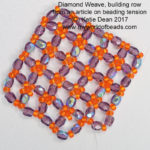 ond Weave. I found this needed a much looser tension than is natural for me. The structure of the Diamond Weave is such that you set up each row, then go back to ‘stabilise’ it. The procedure of stabilising means you are passing through some of the beads again, but with the intention of linking them to different beads, thus changing their alignment a little. If your set-up uses very tight tension, then it is harder to realign the beads. They are locked tight into place in that initial set up. So, I found I had to slightly loosen my tension for the first part, then the stabilising row would lock everything nicely into place.
ond Weave. I found this needed a much looser tension than is natural for me. The structure of the Diamond Weave is such that you set up each row, then go back to ‘stabilise’ it. The procedure of stabilising means you are passing through some of the beads again, but with the intention of linking them to different beads, thus changing their alignment a little. If your set-up uses very tight tension, then it is harder to realign the beads. They are locked tight into place in that initial set up. So, I found I had to slightly loosen my tension for the first part, then the stabilising row would lock everything nicely into place.
For stitches like netting and Right Angle Weave (RAW), you might think loose tension would be an advantage. These techniques are great for creating a loose fabric with plenty of movement. The problem is, as the beads are added in these techniques, they are held in place simply by the thread, not ‘locked’ against one another. So, even if you have a natural tendency towards tight tension, you can still find your beadwork feels very loose. Again, I will come back to give you some tips to help with this below.
Materials that Help (or Hinder) Beading Tension
Hopefully by now you have realised that beading tension has to do with how tight you pull your thread as you add your beads. Well, have you ever thought about how the thread might help you here? Have you also thought about how the beads themselves can help, or hinder?
Thread and Beading Tension
Let’s start with the thread. Did you know that there are broadly two types of beading thread: 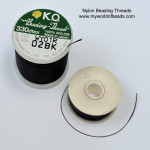 nylon-based and monofilament-based. The nylon-based threads include Nymo, KO, S-lon, C-lon. Basically, these are the threads that feel and behave more like sewing cottons. The monofilament-based threads include Fireline, T-line and so on, and are basically a derivative of fishing line. They feel and behave quite differently to the nylon-based thread.
nylon-based and monofilament-based. The nylon-based threads include Nymo, KO, S-lon, C-lon. Basically, these are the threads that feel and behave more like sewing cottons. The monofilament-based threads include Fireline, T-line and so on, and are basically a derivative of fishing line. They feel and behave quite differently to the nylon-based thread.
What you may not have realised is, the nylon-based threads have a natural propensity to stretch. You might have been told by a tutor to stretch your thread before using it. Possibly you know something about conditioning thread. You may also have wondered why any of this matters! If you use the thread just as it is, it will impact on your tension. If you have tight tension, it can actually help because the thread will stretch of its own accord, allowing the beads that room to manoeuvre that I mentioned above.
Even without taking tension into account, the natural stretch in the nylon based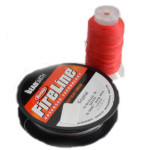 thread can occur over time. This will have an adverse effect on beadwork that needs to hold its shape. However, I don’t want to get on to thread here – that is another whole topic in itself! I will just finish by saying that I think the monofilament-based thread is ideal to help if you do have loose tension. You will be able to pull the thread tight and, as it doesn’t stretch further, this could be enough to get the tension you desire.
thread can occur over time. This will have an adverse effect on beadwork that needs to hold its shape. However, I don’t want to get on to thread here – that is another whole topic in itself! I will just finish by saying that I think the monofilament-based thread is ideal to help if you do have loose tension. You will be able to pull the thread tight and, as it doesn’t stretch further, this could be enough to get the tension you desire.
Beads and Tension
Regarding the beads themselves, think about the shape. You may have heard people mention that Delica beads are fantastic materials for Peyote and brick stitch. The reason is, the Delicas are such a uniform cylinder shape. So, the sides of these beads really lock together. If you are looking at how to get good beading tension, then this is a massive advantage.
Rocailles (traditional seed beads) have more rounded edges, so they will not ‘lock’ quite as readily. If you think of even more curved beads, like pearls, the issue of getting them to lock tight becomes even trickier. It is critical that their edges are pulled as close as possible, but harder to do because the curves want to bounce off one another.
How to get good beading tension with the right materials
So, the message I want to put across here is, if you have a natural tendency to bead with a loose tension, you may want to think about working with materials that will help. Delicas will lock together more naturally, so may be a little more forgiving of that loose tension. Fireline thread will naturally tighten tension. I do not mean to suggest you should only use certain types of beads or thread. Hopefully this just gives you something to think about. If you want to practise improving your tension, then the materials you choose for that practice can help you.
Tips for Improving Tension
I promised you some advice about how to ge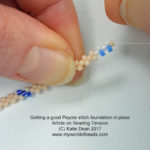 t good beading tension in Peyote stitch. For me, the critical point are those first three rows. If you take time to pull your thread really tight and make sure the beads really form that ‘up’ bead, ‘down’ bead pattern, you set yourself up for great things. When you have completed your third row, you will be able to pull both the working and tail threads to ease the beads tight into position. Then, keep pulling your thread really tight as you add the fourth row. If you get this secure base in place, the remaining rows will naturally sit better.
t good beading tension in Peyote stitch. For me, the critical point are those first three rows. If you take time to pull your thread really tight and make sure the beads really form that ‘up’ bead, ‘down’ bead pattern, you set yourself up for great things. When you have completed your third row, you will be able to pull both the working and tail threads to ease the beads tight into position. Then, keep pulling your thread really tight as you add the fourth row. If you get this secure base in place, the remaining rows will naturally sit better.
 I also promised some thoughts on how to get good beading tension for netting and RAW. If you feel you really suffer with loose tension for these techniques, you can simply repeat the thread path for each row or unit. The first time, as you add the beads, try to pull as tight as you can. Then repeat your thread path through the beads you just added, but pull the thread tight and ease those beads into place. Again, if you can get a stable base in the first few rows, you will likely find the rest is a lot easier.
I also promised some thoughts on how to get good beading tension for netting and RAW. If you feel you really suffer with loose tension for these techniques, you can simply repeat the thread path for each row or unit. The first time, as you add the beads, try to pull as tight as you can. Then repeat your thread path through the beads you just added, but pull the thread tight and ease those beads into place. Again, if you can get a stable base in the first few rows, you will likely find the rest is a lot easier.
Final Thoughts
My final thought is, do not despair! If you feel like you struggle with the thorny issue of how to get good beading tension, then it helps to simply understand how the tension works. Once you get that, you can work on doing things a bit differently to help. It may not come naturally to change, but try using some of the tips I have mentioned. In this way, you will start forming good habits, then the permanent change will follow.
As with much of beading, getting it right is something that comes with practise and experience. The more techniques you try, the more you will feel the difference between tension. As your fingers get used to working with the needle and thread, they will naturally find what feels right. So, just keep persevering, keep observing your work and keep following good advice from tutors. You will get there in the end!
Pattern Links for Practise
Click on the images to go to the pattern download. These patterns are all simple, so you can focus on the issue of how to get good beading tension while you work.
If you found this information on how to get good beading tension was helpful, then remember to sign up to the blog for more great advice ..and don’t forget to share this with your friends!



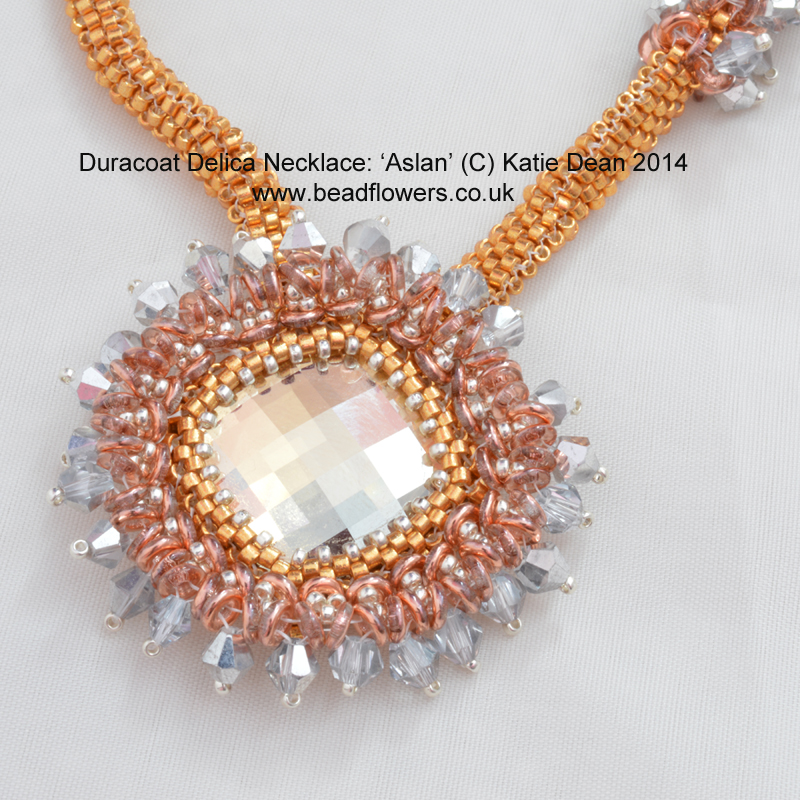

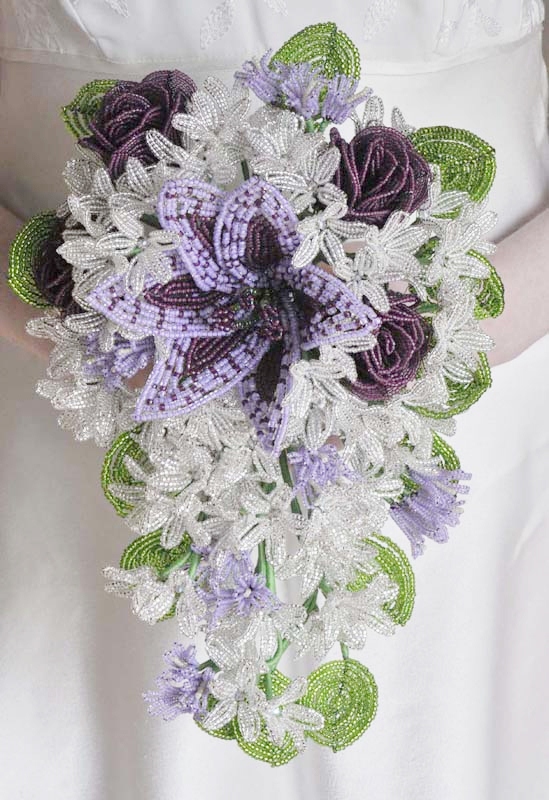






I am new at peyote beading & I don’t know how to tighten my thread to eliminate gapes in my bracelet. Can you help?
Also am having great difficulty in threading a needle.
Thanks Patricia. Basically, if you have followed my tips here to get good tension in the starting rows (so make sure you pull both the tail thread and working thread tight, so those first few rows slot into place well), then you just need to pull your thread tight every time you add a new bead. For some people, this comes naturally. Others need to make a bit more effort to think about it. Using delica beads will help with Peyote because they slot tight into place, so that makes life easier.
Regarding threading the needle, did you see this post which gives my top tip… https://www.myworldofbeads.com/how-to-thread-a-needle/
I hope that helps. Enjoy the beading!
Hello, I am beading a walking stick. I want to have a straight line for my design, but I am getting twists so therefore my design is not straight. Is it all in getting used to the tension. Should I pull the thread down versus pulling side ways? I am using the nylon beading thread with size 13 cut beads. Any suggestions will help. Thank you, Karen
Hi Karen, thank you for your question. It’s a bit tricky to answer this one. But yes, tension will have a lot to do with it. Tension is probably the hardest thing to teach in beading. Everyone has a natural tension and a natural way of working. So, yes, you can definitely experiment with the direction in which you pull your thread. You might also play around with how hard you pull it. And also your choice of thread will make a big difference. So, you could try switching to a different thread (perhaps a non-nylon variety) and see what that does.
You haven’t actually said, but I’m assuming you are working Peyote stitch. If you have a small number of beads per row then tubular Peyote does tend to twist anyway. So, you can actually take time to just straighten the work with your hands at the end of each row.
I hope those tips help!
Hi there! First of all, I love beading and love your site! I recommend it to all my friends who want to start beading! Anyway; for a while I was scared of brick stitch (Not totally sure why haha) but recently I got into it. I am making a lot of earrings with lots of increases and decreases. What I’ve noticed and what drives my perfectionist self INSANE, is that it starts to curve in on itself. From reading your posts about tension, I am assuming that’s what the problem is. So what amount of tension do you recommend? It’s hard because it has to be tight enough to fit together and I think I might just be pulling it quite tight out of habit and not paying attention to my tension but I am overwhelmed. The curving has driven me so mad that I’ve gone to the extent of just cutting them up and taking it apart. Please help! I am desperate and somewhat on the verge of giving up! Thanks for coming to my TED talk
You’re quite right, Giselle, this will be a tension issue. The only thing to do is to experiment, just be aware of your tension as you bead and keep the beads sitting as flat as possible. Please also be aware that your choice of beads will affect this issue too. If you are working with rounded seed beads, their natural un-evenness can cause this kind of shaping problem. It should be less of an issue if you use delicas or other cylinder beads.